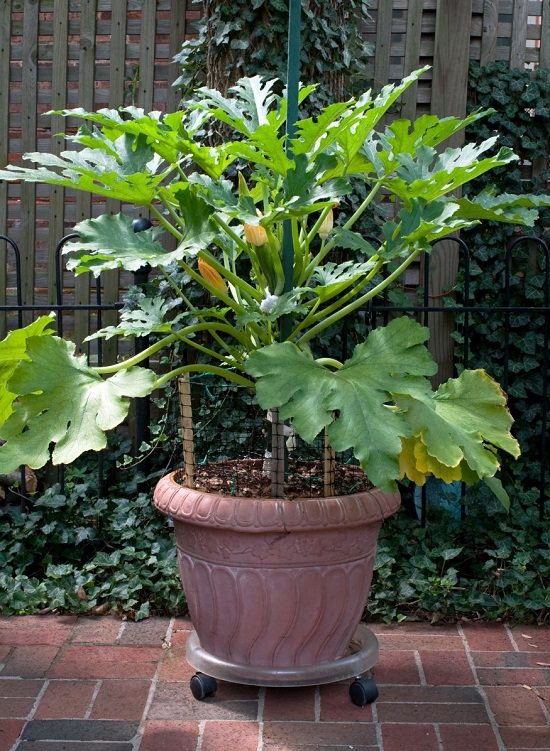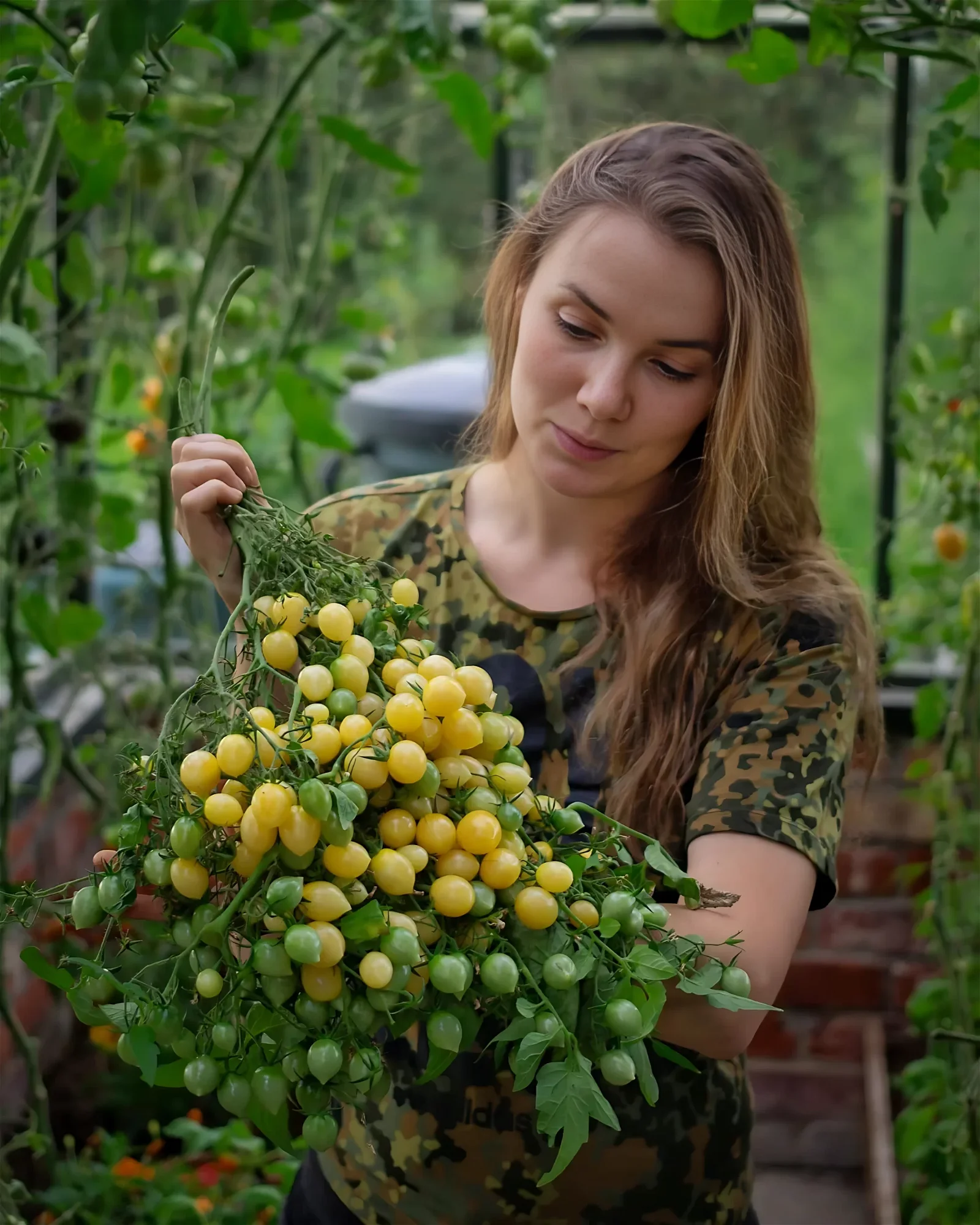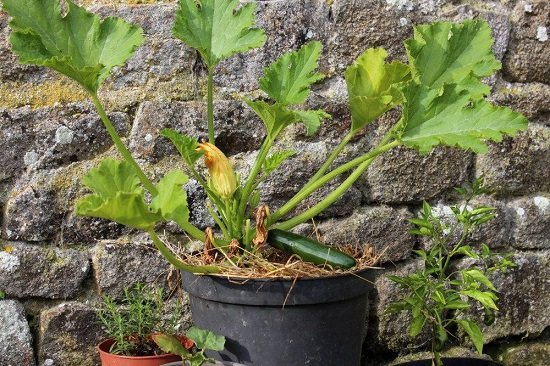Learn How to Grow Zucchini in a Pot Successfully and enjoy a fresh and organic harvest in a small space all year round with ease!
Even if you have a shortage of space, you can grow this vegetable in pots on your balcony, rooftop, or patio. Let’s have a look at How to Grow Zucchini in a Pot.
Learn how to grow cilantro in a pot here
Best Varieties to Grow in Pots

Choosing a Container
A 14-16 inches deep and wide pot is apt for one zucchini plant. Whether you choose plastic, ceramic, or terracotta, make sure it has sufficient drainage holes.
Compact varieties like Gourmet Gold, Magda, Bush Baby, Golden Egg, and Patio Star can even be grown in 8-12 inches pots.
Plastic pots are cheaper and lightweight, but they are also non-porous and may encourage water-logging. Ceramic pots are attractive yet heavy and non-porous. However, clay pots, being porous and aesthetic, offer the perfect balance. Not just that, you can also house zucchini in burlap sacks and grow bags, and of course the railing planters of your balcony garden!
Requirements for Growing Zucchini in a Pot
Location
Place your zucchini plant growing in a container in the sunniest possible location with some air circulation. An area that receives six to eight hours of sun exposure will work fine for the plant.
Soil
Zucchini requires a rich and well-draining potting mix that can also retain some moisture. Make sure your soil is crumbly and has plenty of organic matter like compost or aged manure, or leaf mold.
Like all squash family plants, zucchini grows best in mildly acidic to neutral soil (pH: 6.0 to 7.5).
Watering
Zucchini needs a slightly moist growing medium to produce well. This is why you must saturate the soil deeply and frequently before the soil dries out completely.
Ideally, watering at dawn allows the foliage to dry off by nighttime, preventing the colonization of pests and several diseases.
Also, avoid overhead watering, as it mainly directs the water on the foliage, promoting powdery mildew in turn. Instead, trickle water slowly into the soil around the base of the plant so it gets ample time to penetrate before running off.
Temperature
Zucchini is a warm-weather crop that does best in full sunlight. A daytime temperature of around and above 70 F (21 C) and nighttime temperatures above 40 F (4 C) are conducive to their growth.
Wait till the soil has attained at least 60 F (15 C) before starting seeds outdoors. Plants grown in cold soil show stunted growth, and productivity remains low.
Spacing
Zucchini is a pretty bulky plant, producing up to 10 pounds of fruits during the growing season. As a result, overplanting is out of the question. Additionally, this fact helps to ensure 2-3 feet of spacing between adjacent plants.
Doing this also allows air circulation and prevents the spread of diseases. So, the best thing would be to follow the rule of one pot per plant for a better harvest.
Zucchini Plant Care
Fertilizer
A general fertilizer with 10-10-10 N-P-K works best, as it contains nitrogen as well as potassium and phosphorous to stimulate flowering and fruit production.
When using a water-soluble fertilizer, dilute it according to the manufacturer’s instructions.
Apart from that, side-dressing the plant with well-rotted manure at the time of transplanting or during the mid-growth is recommended.
Pruning
Pruning zucchini plants help to curb their invasiveness while removing any dead or damaged stems and leaves. Snip off leaves and stems at the base of the plant once they turn yellow and crispy or when you find one tangling the other.
Composting
Composting is an accurate way to ensure soil drainage and prolonged water retention. Spread a two-inch deep layer of compost over the soil and work it in, up to 8-inches deep, before planting your crops.
Composting slows down water intake in sandy soils while making it easier to access the compacted soil mixes.
Mulching
Zucchini does well with springtime mulching. Spread two-inch of organic mulch, involving shredded leaves and grass clippings, around seedlings. The mulch will warm up the soil, maintain steady temperatures during growth, and will also promote moisture retention.
Pests and Disease
Zucchini plants are particularly sensitive to fungal diseases and insect attacks. Safeguard them from insects by keeping these points in mind.
- Grow disease-resistant container varieties of zucchini.
- Remove infected leaves to prevent spread, and do not compost them.
- Use copper dust thrice a month to limit the spread of fungal diseases.
- You can also apply wood ash to reduce disease problems.
- Do not water the foliage. Drip irrigation is a more controlled way of watering, as it keeps the leaves in good condition.
Pollination
Before pollinating, you need to understand how the male and female flowers look.
- Male flowers have straight and thin stems behind the petals. They have powdery, yellow pollens.
- Female flowers have tiny immature zucchini fruit at the back of the petals.
- It is best to hand pollinate them in the morning, as they open for a long duration at that time.
- Using a brush, take the pollen from male flowers and gently brush it over fully opened female flowers. This will increase your fruit production!
Harvesting
The plant will be ready to harvest in 45 to 70 days. When the squash becomes 6-10 inches in length, it’s time to harvest it. While picking, do not pull off the fruit away, hastily, from the plant, rather make a clean cut using a sharp knife.




Yes but pictured above are cucumbers not zucchini.
LOL are you new? Those are definitely not cucumber plants. Those are zucchini… period!!
They’re neither, they’re courgettes! Bloody Americans! 😃
Seriously, thanks for the great advice.
Correct they are zucchini plants. They are exactly what mine look like.
You are mistaken – definately zucchini
No, not cucumbers. Look at the plant.
The article was very informative, my biggest problem with growing zucchini is the squash bug attacks .I no there are a lot of methods what is your best line of defense against them? Is it best to just buy a bag of potting soil and put in a pot ,seems like direct soil contact is a failure in most cases. I will try your methods ,thanks for your info.
Plant later, rather than earlier. Our area regularly see the squash bugs in May & June. Due to health issues for my husband, I didn’t get the majority of my alsquashes seeded until late June, & planted in the berms in mid-July. NO problems from squash bugs that year, bumper harvest of several varieties of squash & pumpkins!
Zucchini fruits that rot at the flower end of the fruit the end opposite the stem are commonly suffering from blossom-end rot. This is caused by a lack of calcium in the soil; calcium is important for plant cell wall development. Side dressing the plants with a fertilizer that contains calcium will alleviate this problem for hew fruits that develop on the vine. It the fruits are rotting at the stem end, this may be a sign of a bacterial disease associated with excess water or a bacterial organism in the soil that has infected the fruit because it is sitting in soil too wet. Bacterial diseases and other diseases in the garden often take hold and spread when plants are planted too close together and there is insufficient air circulation or the soil is poorly drained and stays wet. Leaves and fruits turning white may be a sign of fungal diseases such as powdery mildew or downy mildew. The white you see is fungal spores that grow rapidly and spread. Overwatering and too much nitrogen in the soil can cause mildews to grow and spread; spacing plants further apart can slow fungal diseases. All of the above said, an alternative cause of the fruit rot and fruit and leaves turning white is too little water. If that is the case, the leaves will be papery and brittle as a result of sunburn.
Please check your link. The following statement is incorrectly written:
‘Zucchini plants are monoecious, which means the male and female flowers are borne on separate zucchini plants. In other words, pollination must occur between both genders of plants for fruits to form’
Yes, the plants are monoecious but NOT on separate plants (if that were the case, you would have a male zucchini plant that never gave you any fruit)